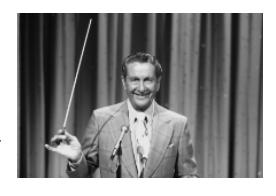A 1981 episode of The Lawrence Welk Show called “Backstage with Our Musical Family” promised a behind-the-scenes peek at Welk’s impossibly wholesome cast as they readied for a performance. Despite the title, viewers didn’t see musicians rehearsing, sets being assembled, mistakes, retakes, and frustrated a capella singers—instead they saw more of the same polished songs and dances they saw every week. Welk knew his audience. He knew they wanted to escape even deeper into his chiffon world, a place where everything and everyone wears a veneer of unfettered ease, even in the off-hours. Any simulation of people actually working to create this effect would have been at odds with the Eden that Welk strived to create for his viewers: a place of organic effortlessness and beauty where troubles, backstage or otherwise, are nowhere to be seen.
In this way, The Lawrence Welk Show distinguished itself from competing TV variety hours such as The Ed Sullivan Show, which invited in, as a matter of regular programming, the conflicts of the outside world. You couldn’t watch the Doors or the Stones on Sullivan’s show—then or now—without being reminded of the countercultural turmoil that raged beyond the screen. And even variety-show staples like plate-spinners and knife-throwers brought with them the tense possibility of unintended spills. Welk’s hour-long world—with its smiling singers, brightly colored sets, color-coordinated male and female outfits, and flawless band performances—had none of this stress. His was a sealed-off, accident-free utopia sound-tracked by an endless supply of what the maestro called “champagne music.” Once a week, Welk presented viewers with one of the most otherworldly—and most underappreciated—psychedelic chiffon musical paradises ever seen on TV.
*
Until 1965, The Lawrence Welk Show was filmed in black and white. While willfully eccentric in their own way, these earlier shows suffer from a desire to make the performers’ outfits and the sets, which often changed dramatically from song to song, appear, at least by Welk standards, realistic. In one episode, Norma Zimmer wears an elaborate gypsy costume as she sings in front of a beaten-up covered wagon. In another episode, Pat Boone croons “Moody River” before a set full of trees, rolling mists, and dense vegetation. But all of this made for a kind of tired, familiar blandness, the type of sets viewers had seen on many other shows. After the shift to color, Welk abandoned the period-precision costumes, props, and sets, making way for something completely and unnaturally vibrant. Nothing on Welk’s stage was ever worn or moody—or remotely realistic—again.
The stylized sets, with their treacly lighting, have...
You have reached your article limit
Sign up for a digital subscription and continue reading all new issues, plus our entire archives, for just $1.50/month.
Already a subscriber? Sign in





